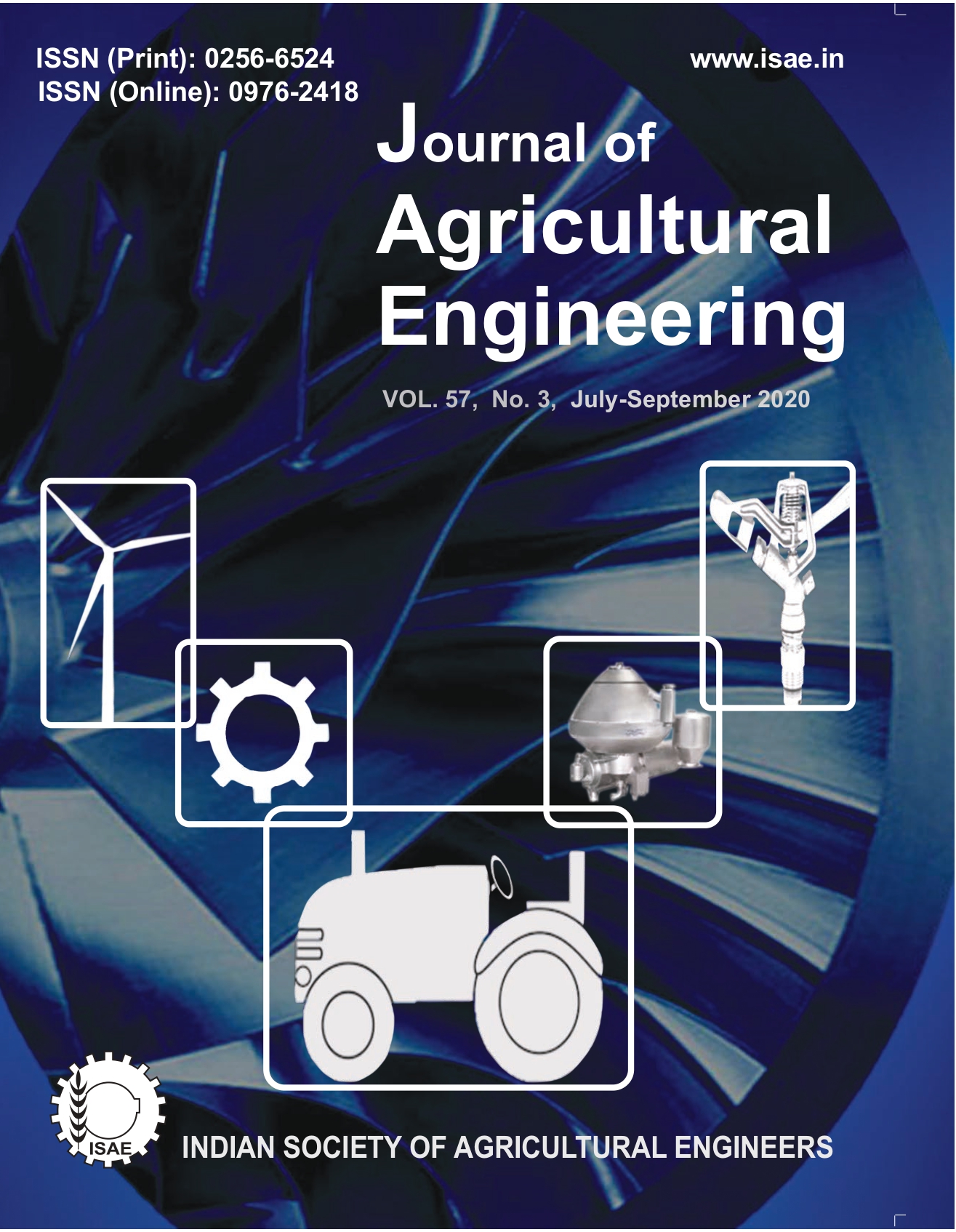Rheological and Surface Properties of Edible Coating Solution Prepared from Vasa Plant (Justicia Adhatoda L.) Leaf Extract
DOI:
https://doi.org/10.52151/jae2020573.1718Keywords:
Edible coating solution, Justicia adhatoda, antioxidant property, rheological properties, surface tensionAbstract
Incorporation of plant extract into edible coating solution (ECS) enhances the antimicrobial and antioxidant property of the coating solution. Vasa plant (Justicia adhatoda) was selected and tested for total antioxidant capacity using phosphomolybdate method. Ethanolic extract of Vasa plant was found to contain 94.47 mg.ml-1 in equivalence of ascorbic acid for 24 hours of maceration. ECS suspension using ethanolic extract of vasa plant (3 %, 6 %, 9 %) was prepared with starch (4 %), sucrose (1 %, 1.25 %, 5 %) and glycerol (10 %, 15 %, 20 %) as base material at different proportions; and the rheological and physico-chemical properties of the ECS were determined. Prepared ECS followed Herschel-Bulkley flow curve having yield stress of 2.37-4.74 Pa and n-value in the range of 0.26-0.95. Further, the pH (6.2-6.9) and surface tension (58.10- 81.90 m. N.m-1) of the ECS significantly (p<0.05) decreased by the increase in Justicia adhatoda extract. Electrical conductivity and total soluble solid of the formulated ECS ranged from 0.17-0.36 dS.m-1 and 1.7-3.9 °Brix. respectively, and both of them significantly (p<0.05) increased with increase in sucrose and Justicia adhatoda extract. Optimized ECS contained 1.04 % sucrose, 18.44 % glycerol and 9.00 % Justicia adhatoda extract.
References
Andrade R; Osorio F. 2012a. Experimental study of drop impacts and spreading on epicarps : Effect of fluid properties.J. Food Eng., 109(3), 430-437.
Andrade R D; Skurtys O; Osorio F A. 2012b. Atomizing spray systems for application of edible coatings.Com. Rev. Food Sci. Food Saf., 11, 323-337.
Barth A; Hovhannisyan A; Jamalyan K; Narimanyan M. 2015. Phytomedicine antitussive effect of a fixed combination of Justicia adhatoda, Echinacea purpurea and Eleutherococcus senticosus extracts in patients with acute upper respiratory tract infection: A comparative, randomized, double-blind, placebo-contro. Phytomedicine, 22(13), 1195-1200.
Bhattacharyya D; Pandit S; Jana U; Sen S; Sur T K. 2005. Hepatoprotective activity of Adhatoda vasica aqueous leaf extract on D -galactosamine-induced liver damage in rats. Fitoterapia,76(2), 223-225.
Chen Y F; Yang C H; Chang M S; Ciou Y P; Huang Y C. 2010. Foam properties and detergent abilities of the saponins from Camellia oleifera. Int. J. Mol. Sci., 11(11), 4417-4425.
Debeaufort F; Voilley A. 2009. Lipid-based Edible Films and Coatings. In: Huber K; Embuscado M (Eds.) Edible Films and Coating for Food Applications, Springer, New York, NY,135-168.
Fadini A; Rocha F; Alvim I; Sadahira M; Queiroz M; Alves R; Silva L. 2013. Mechanical properties and water vapour permeability of hydrolysed collagen– cocoa butter edible films plasticised with sucrose. Food Hydrocolloids, 30(2), 625-631.
Franssen L; Krochta J. 2003. Edible Coatings Containing Natural Antimicrobials for Processed Foods. In: Nat Antmicrobials Minimum Processing of Foods, Woodhead Publishing Series in Food Science, Technology and Nutrition, Elsevier, New York, NY, 250-262.
Grigelmo-Miguel N; Ibarz-Ribas A; Martı́n-Belloso O. 1999. Rheology of peach dietary fibre suspensions. J. Food Eng., 39(1), 91-99.
Izbassarov D; Muradoglu M. 2016. Effects of viscoelasticity on drop impact and spreading on a solid surface.Phy. Rev. Flu., 1(2), 1-18.
Jaworek A. 2007. Electrospray droplet sources for thin film deposition. J. Mat. Sci., 42(1), 266-297.
Jones J R; Paterson A; Pearce D L. 2016. Droplet impact and spreading : Droplet formulation effects. Chem. Eng. Sci., 62(9), 2336-2345.
Karthikeyan A; Shanthi V; Nagasathaya A. 2009. Preliminary phytochemical and antibacterial screening of crude extract of the leaf of Adhatoda vasica. L. Int. J. Green Pharm., 3(1),78-80.
Kaur R; Ruhil S; Balhara M; Dhankhar S; Chhillar A. 2013. A review on Justicia adhatoda: A potential source of natural medicine. Afr. J. Plant Sci., 5(11), 620-627.
Mazumdar B C; Majumder K. 2003. Methods on Physico-chemical Analysis of Fruit. Daya Publishing House, Delhi, 112-115.
Moreno O; Pastor C; Muller J; Atarés L; González C; Chiralt A. 2014. Physical and bioactive properties of corn starch – Buttermilk edible films. J. Food Eng., 141, 27-36.
Muscat D; Adhikari B; Adhikari R; Chaudhary D. 2012. Comparative study of film forming behaviour of low and high amylose starches using glycerol and xylitol as plasticizers. J. Food Eng., 109(2), 189-201.
Nouri L; Nafchi A M. 2014. Antibacterial, mechanical, and barrier properties of sago starch film incorporated with betel leaves extract. Int. J. Biol. Macromol., 66, 254-259.
Oliveira L M; Cereda M P. 2007. Sucrose and inverted sugar as plasticizer. Effect on cassava starch – gelatin film mechanical properties, hydrophilicity and water activity. Food Chem., 103(2), 255-262.
Pa R; Mathew L. 2012. Antimicrobial activity of leaf extracts of Justicia adhatoda L. in comparison with vasicine. Asian Pac. J. Trop. Biol., 2(3), S1556-S1560.
Prieto P; Pineda M; Aguilar M. 1999. Spectrophotometric quantitation of antioxidant capacity through the formation of a phosphomolybdenum complex: Specific application to the determination of vitamin E. Anal. Biochem., 269 (2), 337-341.
Rajesh G; Thirupathi V. 2014. Effect of plasticizers on rheology of banana flour and the mechanical and functional properties of banana flour composite films. Trends Biosci., 7(15), 2043-2048.
Ruenroengklin N; Zhong J; Duan X; Yang B; Li J. 2008. Effects of various temperatures and ph values on the extraction yield of phenolics from litchi fruit pericarp tissue and the antioxidant activity of the extracted anthocyanins. Int. J. Mol. Sci., 9(7), 1333- 1341.
Saha D; Hait M; Patanwar M; Tamrakar A. 2011. Studies on surface tension of selected juice formulation by drop number method using Traube’s Stalagmometer technique. Bul. Pharma. Res., 1(3), 1-3.
Veiga-Santos P; Oliveira L; Cereda M; Scamparini A R P. 2007. Sucrose and inverted sugar as plasticizer. Effect on cassava starch–gelatin film mechanical properties, hydrophilicity and water activity. Food Chem., 103(2), 255-262.
Yusof Y; Shukur M; Illias H; Kadir M. 2014. Conductivity and electrical properties of corn starch– chitosan blend biopolymer electrolyte incorporated with ammonium iodide. Phys. Scr., 89(3), 35701- 35711.














